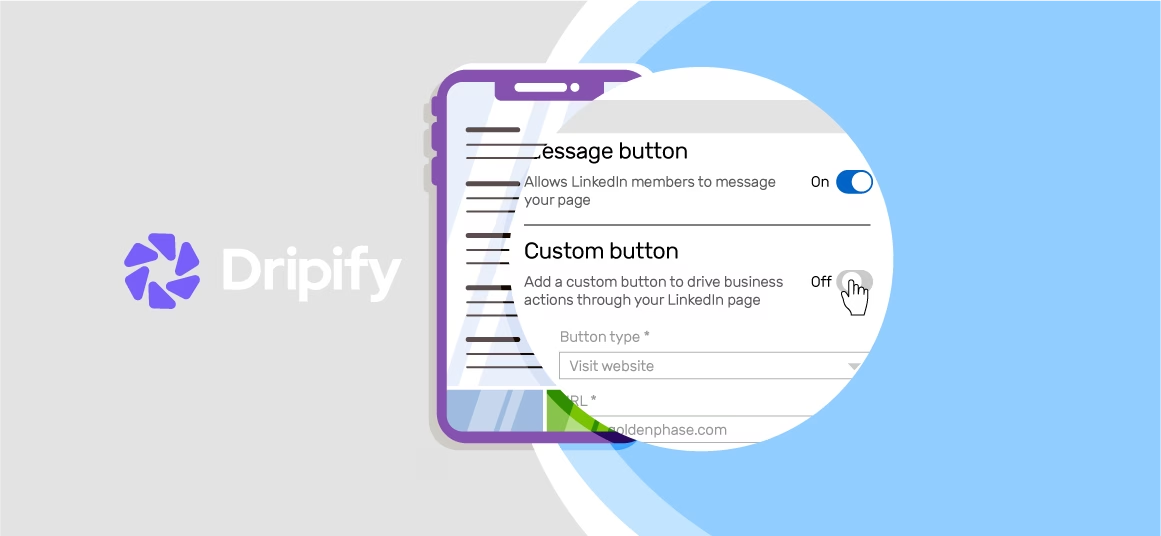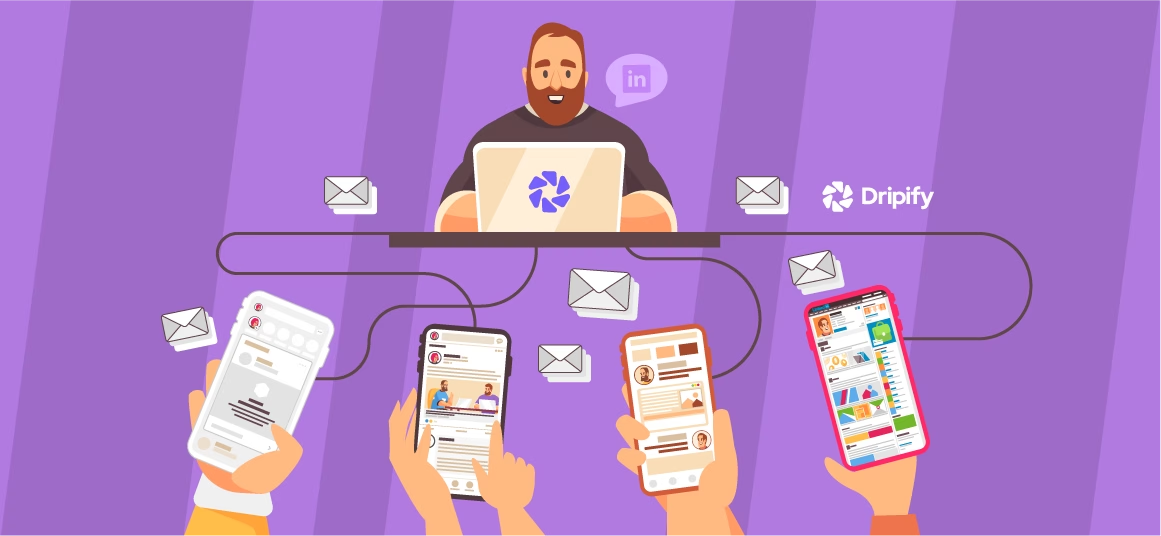B2B sales is a challenging yet rewarding field of business. It’s a shark-infested pool filled with brilliant, hard-working salespeople constantly battling over the same dollar. If you’re willing to put in the work, you’ll see your efforts produce results fairly quickly.
Without further ado, let’s look at what B2B sales is, how the sales process works, the essential strategies you need to grow your B2B sales business, and much more.
- What Is B2B Sales?
- How the B2B Sales Process Works
- 1. Conducting Research
- 2. Finding Customers
- 3. Conducting Outreach
- 4. Pitching Leads
- 5. Following Up
- 6. Closing the Sale
- Tips to Do Successful B2B Sales
- 1. Focus on Personalization
- 2. Listen Closely
- 3. Don’t Worry About the Price
- 4. Keep Growing
- 5. Conduct Continuous Seller Training
- 6. Do More Than Selling
- 7. Keep in Touch
- Examples of B2B Sales
- 1. Supply Sales
- 2. Wholesale/Distribution Sales
- 3. Services/Software Sales
- What Is a B2B Sales Funnel?
- Awareness
- Interest in your service/products
- Consideration
- Decision-making
- Purchase
- Evaluation
- Satisfaction/Dissatisfaction
- Repurchase/Attrition
- What Is the Difference Between B2B Sales Funnel and B2B Sales Process?
- Best B2B Sales Strategies
- 1. Strategic Selling
- 2. Solution Selling
- 3. Account-Based Selling
- 4. Social Selling
- How to Generate Leads for B2B Sales?
- 1. Use live sales chat
- 2. Master outbound calling
- 3. Offer quality training
- 4. Keep sales and marketing in agreement
- 5. Do your research
- What Are the B2B Sales Challenges?
- 1. Lack of content
- 2. Prolonged sales cycle
- 3. Data overload
- 4. Lack of customer confidence
- 5. Technological deficiency
- How to Measure Your B2B Sales KPIs
- 1. Sales Productivity Metrics
- 2. Tracking Revenue
- 3. New Leads by Source
- 4. Lead to Opportunity Ratio
- 5. Average Lead Response Time
- 6. Average Follow-up Attempt
- 7. Cost of Customer Acquisition
- 8. Closed Monthly Deals
- What Is the Difference Between B2B Sales and B2C Sales
- Why LinkedIn Is Best for B2B Marketing?
- Professional Context
- Precise Targeting
- Effective Data Utilization
- Sponsored Content
What Is B2B Sales?
Business to business (B2B) refers to a sales relationship or transactions between businesses. It is a sales model where one company sells products or services directly to other companies.
Take the case of a paper manufacturer selling its products to a printer or a heavy machinery manufacturer selling its products to a factory. Both of these are examples of B2B sales.
The B2B sales marketing model involves businesses marketing their offerings to prospects and then nurturing them to a point where they convert into customers. Sales reps factor in their prospects’ industries, turnovers, and other elements to determine whether or not they can afford the product being sold.
Furthermore, B2B sales usually involve higher price points, complex processes, and various touch points across multiple channels. Because of this, B2B companies depend on a team of competent and highly-trained individuals to meet target revenue. Also, it involves longer sales cycles and a series of discussions instead of a quick, single transaction.
How the B2B Sales Process Works
The B2B sales process involves well-designed strategies, a defined process, and different techniques for different buyer personas and selling situations. The number of stages in a B2B sales process typically ranges from five to eight, varying by industry, company, and sales organization.
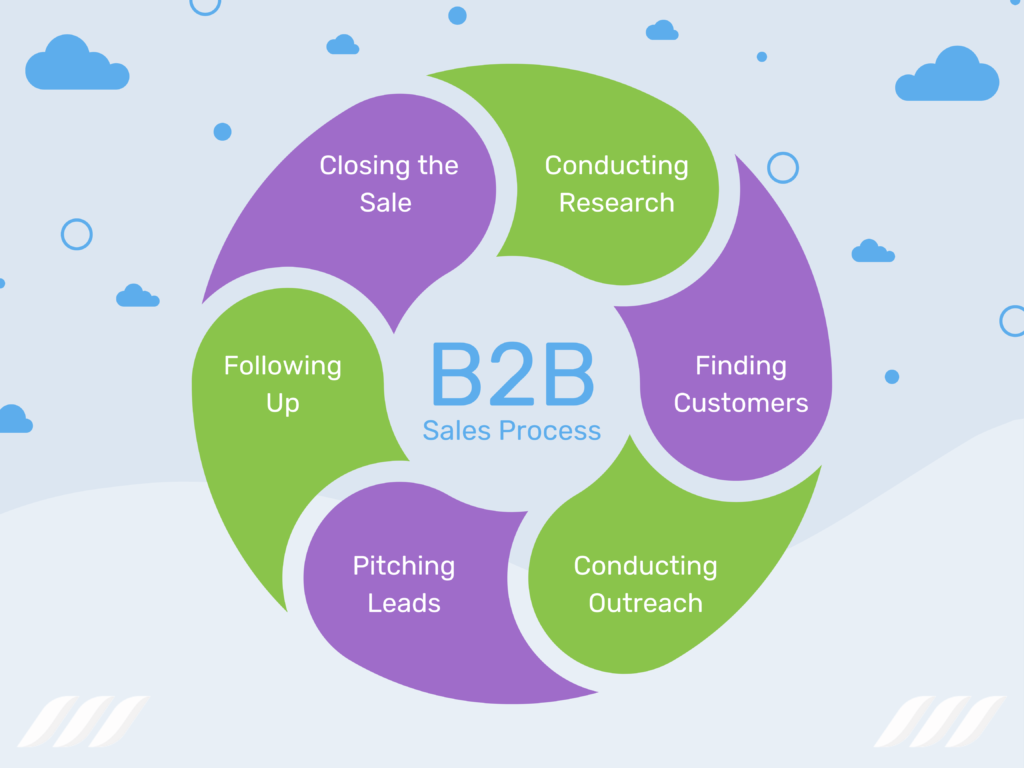
Here’s an example of a 6-stage B2B sales marketing cycle:
1. Conducting Research
Before you begin selling, you must identify your market, competitors, and buyer persona. This ensures that your product or service and value proposition align with the marketplace.
2. Finding Customers
Besides identifying decision-makers, you need to have qualified leads — the ones having the need, interest, and budget to buy your product or services.
For most companies in the B2B sphere, LinkedIn is the best option to find customers. As a sales professional, this social media platform makes it super easy to research your leads’ recent activities and get an insight into their pain points. Plus, you can always visit your target’s company website to see what information you can use in your calls.
3. Conducting Outreach
After analyzing the market, competition, and your target audience, the next step is to reach out to nurture a mutually beneficial relationship. This step may involve inbound and outbound marketing strategies. But before you make a sales call, it’s essential to put in the groundwork and understand your prospect’s pain points.
4. Pitching Leads
Now that you’ve done the groundwork, it’s time to pick up the phone or create a LinkedIn InMail message to pitch to your prospects.
This is where you propose how your products/services solve your prospects’ problems while presenting yourself as an authority in the niche. It is always a great idea to create a pitch adapted to your buyer persona and offers a personalized experience to your audience.
5. Following Up
You’re less likely to pull in many prospects right after your pitch. Most cases involve a bit of following-up before closing the deals.
There are two ways salespeople typically follow up in the B2B sector:
- Ensuring whether or not prospects need any additional information regarding your offer.
- Follow up with leads who consent to be contacted a few days later and discuss things further.
6. Closing the Sale
So, you could finally convince your prospects to avail your business offerings. All that remains is to get them to sign the proposal or contract. With this final, yet usually the most straightforward, stage, you can complete your B2B sales process.
Tips to Do Successful B2B Sales
Here are 7 B2B sales best practices that would help you close more deals:
1. Focus on Personalization
It is never a good idea to take a rigid approach while presenting solutions to your prospects. Instead, try to initiate more personalized communications and use technology to scale customization. Your salespersons should be proficient at tweaking presentations to fit your audience’s needs.
2. Listen Closely
Closely listening to your potential buyers and understanding their needs would get half the job done. Therefore, your sales team shouldn’t be doing more than 30% of the talking in their initial sales calls. Besides, listening ensures that your prospects feel valued, which leads to higher engagement down the line.
3. Don’t Worry About the Price
If you think you’re charging a reasonable amount for your offering, stand behind your price. Your prospects won’t balk at prices if your offer truly solves their problem. Instead, use the situation to force your competitors to narrow their margins.
4. Keep Growing
It is always good to use CRM and marketing automation to make solid decisions and manage the lead generation process. Plus, use data and adopt new technologies, such as sales engagement platforms, to smoothen the process.
For instance, a platform like Salesforce should be the cornerstone of B2B sales strategies. The right Salesforce CRM integration would help you capitalize on predictive analytics and improve your efficiency and performance.
5. Conduct Continuous Seller Training
B2B buyers keep evolving, and they value sellers who know what they do while showing empathy and sensitivity. As such, it makes sense to train your sellers to be able to think critically and add perspectives to their thinking.
6. Do More Than Selling
As much as B2B sellers require continuous education, they need to be educators. A competent salesperson would develop great solutions for their customers and help them understand the root cause of their problems and how it’s being solved.
7. Keep in Touch
Given that B2B sales cycles tend to be longer than other sales cycles, it takes time to cultivate and nurture leads. For this reason, be sure to devise strategies to stay connected with your leads at every stage of the sales cycle. Also, encourage, monitor, and display customer feedback. Include case studies and customer stories in your sales strategy.
Examples of B2B Sales

Here are examples of B2B sales that fit into three broad categories, depending on the business model and product types.
1. Supply Sales
A supplier sells consumables that keep other businesses running. These could be office supplies, employee uniforms, or equipment. While B2C companies follow a similar selling procedure, the quantity and buying authorization differ. If a regular consumer buys one ink cartridge, a procurement officer will buy 50 after getting clearance from the decision-makers.
Lyreco is an office equipment and supplies retailer. It is a good example of a business specializing B2B sales of this kind.
Also, take the example of B2B supplies company Mallory Safety & Supply, which works in the B2B e-commerce storefront. Mallory deals in safety, industrial cleanroom, and public safety supplies, together with customization options and flexibility.
2. Wholesale/Distribution Sales
A wholesaler sells critical manufacturing or retail components to other businesses. These could include raw materials and raw goods for the manufacturing sectors.
Take Alibaba, one of the biggest B2B e-commerce companies globally, for example. The platform serves 40 industries, selling products to more than 18 million sellers in 240 countries and territories.
On the other hand, JJ Foods is a wholesale food distributor selling food products to restaurants and fast-food outlets, serving products at retail price points.
3. Services/Software Sales
Businesses under this category sell services or software to other companies. Usually, companies avail services and software for internal purposes, such as managing their revenue operations.
For example, in the case of tax accounting, this could be an accountant working with an accountancy firm, who, in turn, works with a larger business. But instead of an individual, the B2B seller can provide this service through tax accounting software as well — Quickbooks, for instance.
What Is a B2B Sales Funnel?
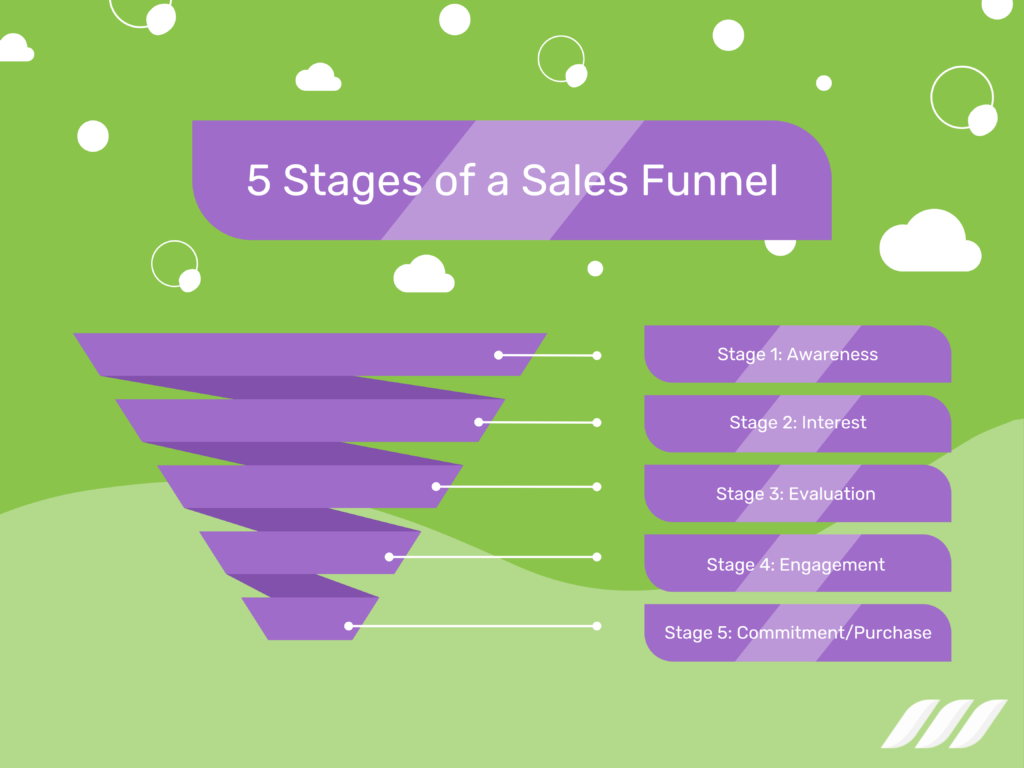
Sales funnel is a popular term in B2B marketing. It describes the process of getting a new lead through the various stages of the sales cycle and closing the deal. As such, creating a sales funnel for your B2B business is crucial.
Here’s a detailed explanation of every stage a prospect goes through in the sales funnel before becoming your customer.
Awareness
In the Awareness stage, prospects are looking for answers, and it might take resources, data, education, opinions, and insights to solve their problems. Your lead’s value is less at this level since there’s no guarantee they’d turn into your buying customers. However, you can elevate their interest levels in your products or services with comprehensive information and high-quality content.
Interest in your service/products
Once you’ve hooked your leads to the point where they believe you can solve their problems, they’d have a lot to ask now. They’d research to get answers to their questions and gain more information about your business. At this stage, you can nurture your leads by creating engaging content. For instance, you might want them to download an e-book or register for your seminar.
Consideration
Some of your leads might be interested in seeing the products in action before making a buying decision. This means you’d want to schedule a demo and provide evidence of your product’s efficacy. But, your prospects might still not be interested after seeing a demo. But if they express interest, they may ask for additional demonstrations to review more features.
Decision-making
The prospects are almost ready to make a purchase decision, but they might need further reassurance that they’re making the right decision.
To push your prospects through to the next stage, consider showing them client testimonials and case studies or create custom resources that satisfy their concerns. The sales reps must be competent enough to address usual concerns such as cost or schedule. But before anything, they must provide at least three solid reasons why the prospect should buy your product.
Purchase
At this point, you’ve convinced your prospects to go ahead with the purchase. However, they may negotiate first to achieve a good price. Contractual obligations follow, and all the parties sign off once the price and terms are settled.
If the prospect makes full payment, you have a closed-won deal. Unfortunately, the prospect might still turn down the final offer at this last moment, resulting in a closed-lost deal.
Evaluation
Now that you’ve closed-won the deal, you’ve boarded your prospects on your business journey. Your customers will closely evaluate your product or service’s performance and your customer service and ongoing support to see if it lives up to the promises.
Satisfaction/Dissatisfaction
Be ready to receive reviews reflecting the accurate feedback of your customers. These reviews would serve as social proof of your business and influence potential customers.
If you fail to satisfy your customers, they will likely leave negative reviews. In this case, you can reach out to them and provide satisfying solutions like credit for the next purchase or refunds. Above all, fix your business model to eliminate whatever led them to disappointment.
Repurchase/Attrition
You can expect three things from your customers once the deal is closed — they’ll repurchase from you, become a brand ambassador for your products and services, or never return to you. In the case of the third consequence, you would want to get their feedback and see what you could do to retain customers.
What Is the Difference Between B2B Sales Funnel and B2B Sales Process?
A B2B sales process represents the entire exercise your sales team makes, with your sales manager keeping track of it. It is brand-focused and has an internal viewpoint, relying on the sales and marketing team to convert a prospect into a customer.
In contrast, a salesperson creates a sales funnel to understand the pathway between leads visiting your site or app and converting into paying customers. For example, if 500 people visited your landing page, but only 20 converted into paid customers, only 4% of that traffic took actionable steps along the journey.
Here’s a table summarizing the differences between B2B sales funnel and B2B sales process:
| B2B Sales Pipeline | B2B Sales Funnel | |
| Visualization | Shows the quantity, value, and stages of open deals. | The funnel provides valuable insight into the volume of open deals at any given time. |
| Tracking | Tracks active leads at different stages of the sales process. | Tracks conversion of leads on a stage-by-stage basis. |
| Measurement | Measures the quality of leads you drive to the pipeline. | Measures the efficiency of your lead generation efforts. |
| Reporting | The sales process report shows lead activity during the sales process. This helps sales teams determine the areas to direct more resources towards for more conversions. | The sales funnel report shows conversion rates throughout the sales process. The data is used to improve individual sales process stages to prevent leaks in the funnel. |
| Buyer journey representation | From the viewpoint of the sales rep | From the viewpoint of the customer |
| Focus | Activity and value-oriented | Performance and quota oriented |
Best B2B Sales Strategies

Here are some of the B2B strategies best practices to boost your productivity and results:
1. Strategic Selling
Strategic selling helps businesses close complex deals through a scalable, insight-driven approach.
First, you identify different points of contact in the organization being prospected based on their influence on your sales process. Next, you must determine the level of support they can provide in the company’s decision-making process.
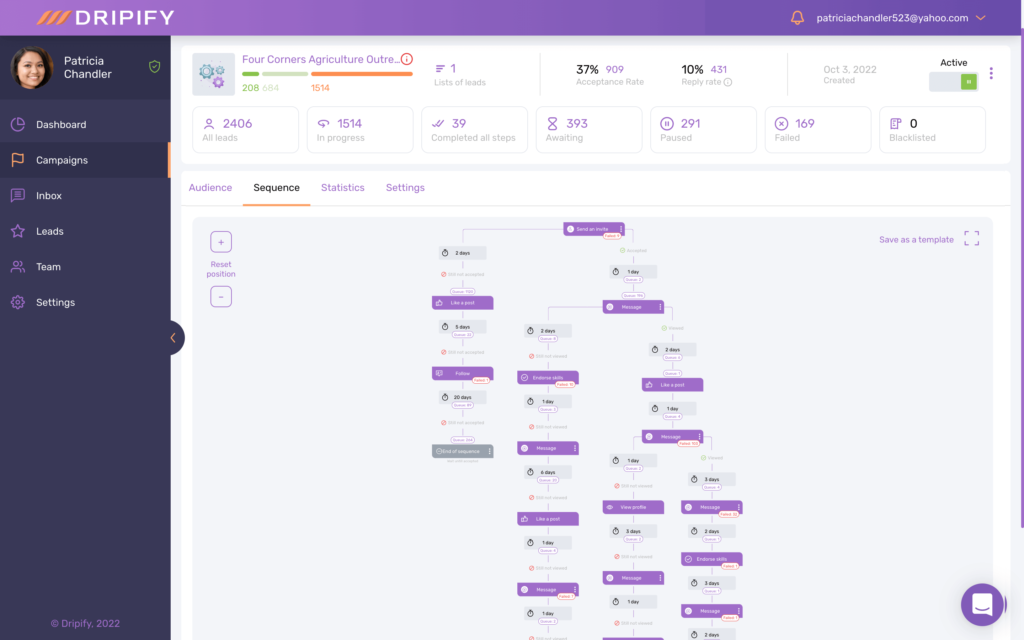
Let’s say you want to sell project management and the best sales automation tools to an organization. In this case, you should approach the operation manager or marketing manager during your outreach. Why? Because a marketing manager would be promoting your software within the company, and the operations manager would be the actual decision-maker.
2. Solution Selling
Instead of focusing on the actual sale process, this strategy makes the prospect’s needs the focal point. In other words, the sales reps focus on digging into prospects’ needs, challenges, and goals.
Next, they suggest products/services that could help overcome these challenges. Usually, this type of sales strategy is put into practice when a business needs a customized solution for its problems.
Solution selling works because the prospects are treated exclusively right from the beginning. When they’re offered tailored solutions, they feel valued. This creates a long-term business relationship, leading to more business.
3. Account-Based Selling
Account-based selling is a multi-touch, multi-channel strategy that treats each account as a market of one. As part of an account-based strategy, the salespersons target “accounts” instead of individual contacts or leads.
First, a business targets high-end accounts, followed by sales and marketing teams collaborating to offer targeted content to establish a connection with multiple stakeholders within those accounts.
Let’s assume you’re selling service management software to a logistics company. Here’s what the process would be like:
- Select target accounts
- Investigate and identify
- Personalized value proposition
- Outreach
Typically, account-based selling works best for companies with complex sales integration and longer sales cycles or rely on the approval of several decision-makers.
4. Social Selling
Social selling is a two-step process:
- Establishing your business in your defined target market
- Focusing on nurturing relationships with the prospect companies
These days, salespersons leverage social networks like LinkedIn, Twitter, and Facebook to share relevant content and draw the attention of prospects and existing customers. You can spark deeper conversations and figure out what they mostly care about by promoting content on channels where prospects are most active.
Social selling can be confused with marketing. But there’s a distinct difference between the two: While social selling is used to build relationships with prospects, marketing just aims to broadcast messages from one to many.
How to Generate Leads for B2B Sales?
Consider improving your B2B sales lead generation by using a combination of the following methods:
1. Use live sales chat
Live sales chat ensures that someone is always on hand to interact with website visitors. It works great to bring down bounce rates and convert your website visitors into warm leads.
Sales chat can provide your website visitors with high-quality, personalized content and information considering their goals, desires, and pain points when executed correctly. By providing an insight into your business, sales chat could generate leads or steer prospects in favor of your services.
2. Master outbound calling
Since a high percentage of sales happen over the phone, mastering outbound calls is crucial to your business. A good outbound calling strategy will help you bring the max out of sales interactions.
Make sure your outbound calling strategy includes:
- Clear goals, including average handle times for calls and close rates
- A strategy to qualify your leads so that you can shape future contact
- Follow-up plans to reinforce the connection with contacts once the call is finished
If you want to use scripts in your calls, make sure they’re designed to provide agents with the support they need instead of tying their hands. In other words, scripts should just be a tool your sales reps could use to their advantage — not some rigid set of rules.
3. Offer quality training
Sales training can motivate and improve your sales team’s skills and maximize their productivity. The right training for your sales team should include:
- Scripts that salespersons can fall back on
- Ways to handle difficult and reluctant customers
- Strategies to qualify leads and warm up existing leads
4. Keep sales and marketing in agreement
If your sales and marketing teams are usually in conflict, you will struggle to achieve your overall sales goals. Here’re a few ways to align your sales and marketing departments:
- Investigate the leading cause of conflict between sales and marketing. In usual cases, arguments occur over “lead quality.”
- Use lead scoring to first qualify and then prioritize the best leads.
- Share, and co-create campaigns, content, and ideas. Encourage insights and equal participation from both teams.
5. Do your research
It is never good to approach prospects with very little chance to respond or buy your product. You must make the best use of your resources through research. 85% of businesses or leads prefer vendors with the knowledge of their industry and the challenges they face.
There you have the key to impressing your prospects — research what they’re interested in. For that, keep tabs on industry news and the latest trends, or probably tune in to the latest podcasts of influencers.
What Are the B2B Sales Challenges?
Here are some B2B sales challenges you could face, together with the solutions to overcome them.
1. Lack of content
Initially, it can be challenging to explain what you’re offering and connect with prospects. Lack of brand visibility and thought leadership can put you behind your competitors. The problem often happens due to a lack of digital marketing content or the failure to deliver content to a target audience.
Solution
Engage marketing and other departments and create content highlighting your products’ solutions to prospects’ pain points and offering value through best practices and relevant industry insights. Consider implementing content marketing strategies like blog-posting or social media campaigns to establish yourself as the industry leader.
2. Prolonged sales cycle
B2B cycles are generally longer than B2C cycles. This comes from the involvement of several decision-makers and more complex deals. A prospect could stay at the top of the sales funnel for months before moving on to the next stages.
Solution
Build trust, create long-term relationships, and nurture your leads. When you find that the leads have warmed up but aren’t yet ready to buy, you could use marketing automation tools to follow up on behalf of your sales reps. This would make the entire sales process more effective and possibly reduce the sales cycle length.
3. Data overload
It can be challenging to maintain a digestible dose of data. Data overload results in wasted time, money, and resources. But more importantly, it would push away your prospects. It inevitably becomes overwhelming when decision-makers are bombarded with a sheer amount of data and features.
Solution
Make the buying process as simple as possible. Focus less on the technicalities and features, and talk more from the customers’ viewpoint. What benefits does your product offer? What problems would the product solve? Also, listen to the buyer’s pain points and customize your communication accordingly. Instead of flooding them up with data, hone in on the kind of analytics and information they’d prefer seeing.
4. Lack of customer confidence
Compared to B2C sales, there’s a heftier monetary investment involved in the B2B sales process. Besides, the transition from an existing product or service to a new one can be complex and extensive. Due to these reasons, decision-makers might be skeptical.
Solution
Most businesses would be content once you prove that your proposed solution has worked successfully for similar companies. This is usually achieved through case studies, testimonials, and other success markers that could remove roadblocks to your credibility and increase buyers’ confidence.
5. Technological deficiency
The digital age has fast-forwarded businesses and redefined how they operate. Not keeping up with technological changes slow down results.
Solution
Use new tools and technologies to simplify your sales teams’ jobs and streamline the process required to overcome other sales challenges. From CRM systems to cloud technology to data analytics to sales automation — embrace the right sales enablement tools to maintain a successful sales operation.
How to Measure Your B2B Sales KPIs
The following are some metrics to keep your eyes on to measure your B2B sales KPIs effectively.
1. Sales Productivity Metrics
By measuring, tracking, and understanding this data, the sales reps would determine what is working for your business. Let’s break it down into more targeted metrics:
- The average time spent on running demos – It’s essential to know how much of the total working duration is dedicated to running demos.
- Time spent on data entry – If your sales team is busy with data entry at the expense of more rewarding aspects of B2B sales, the whole sales pipeline will be hampered.
- Time spent on the phone – This shows the time spent by sales reps on the phone with prospects before closing the deals.
- Percentage of closed deals – This measures the proportion of closed deals over all the deals in the sales pipelines over a specific period.
2. Tracking Revenue
To understand revenue growth better, you need to track a few things:
- Sales volume by location – This is done to identify demand for a product or service and where it’s lacking.
- Percent of sales discount – Knowing the percentages of sales discounts helps identify the most effective discounts.
- The cost of the marketing – This shows the effectiveness of your marketing, sales, and advertising campaigns.
- Customer acquisition costs – These costs are essential as they show how much money is spent to get customers.
3. New Leads by Source
This KPI metric shows you many vital tools for scaling your business. First, it tells the amount of information you have about your leads. Secondly, it tells the number of leads going through the sales pipeline and their origin. This indicator shows how to best target your prospects and where to locate them when combined.
4. Lead to Opportunity Ratio
The lead to opportunity ratio indicates how many leads are turning into sales opportunities. This KPI can also be measured in terms of your sales team’s efforts to qualify a lead into an opportunity. This is an important metric because it enables you to quantify opportunities coming into your sales pipeline every month.
5. Average Lead Response Time
The average lead response time measures the time needed to follow up with an engaged prospect. This metric provides an insight into why some potential customers are lost — slow response time, for instance. Besides, it also presents the likelihood of a conversion, considering a timely and useful response.
6. Average Follow-up Attempt
Another helpful metric is the average follow-up attempt your sales team makes, measured from the beginning of outreach to the end of the activity. This is a useful metric because it indicates your sales reps’ persistence in contrast to the lead’s interest in your products and services.
7. Cost of Customer Acquisition
With customer acquisition cost (CAC), the sales team can ensure you’re making more than you’re investing. CAC tells how much you’re spending on each lead that converts into a customer.
Sales teams use this formula to calculate CAC: CAC = money spent on client acquisition over a specific time divided by the total number of customers you got in that time.
8. Closed Monthly Deals
Closed monthly deals are a straightforward yet helpful metric that measures the percentage of closed-won deals every month. You can set a monthly quota for your sales team by tracking this number. Also, tracking this KPI helps you set realistic goals for your sales team and assess your business finances better.
What Is the Difference Between B2B Sales and B2C Sales
As the names imply — business-to-business and business-to-consumer — both sales types differ in target markets. B2B sales involve the selling of products and services to other businesses. Conversely, B2C companies sell to the general public. For example, a hair salon targeting people who want a haircut is B2C sales.
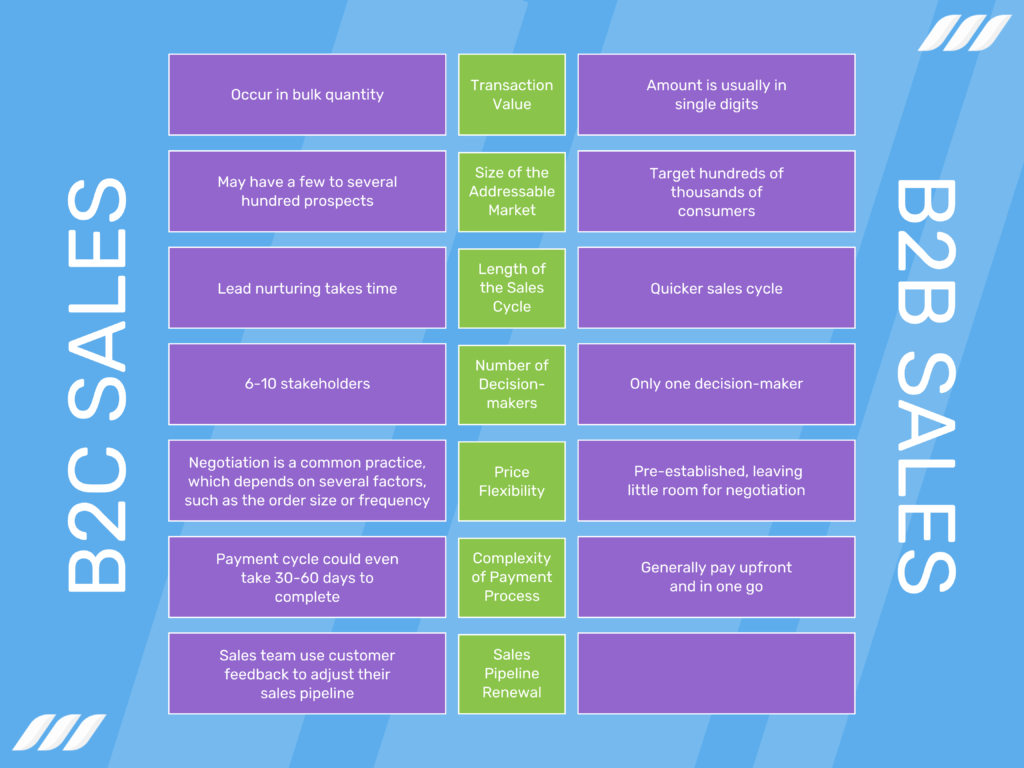
Here are a few major differences between B2B sales and B2C sales:
Transaction value – B2B products and services bring higher profits than their B2C counterparts. This is because B2B sales occur in bulk quantity, unlike B2C where the amount is usually in single digits.
Size of the addressable market – B2C companies target hundreds of thousands of consumers, while B2B businesses may have a few to several hundred prospects.
Length of the sales cycle – Since B2B prospects depend on measurable advantages to influence their buying decision, lead nurturing takes time. In the case of B2C sales, the end-users are likely to make impulsive buying decisions, making the B2C sales cycle quicker.
Number of decision-makers – On average, you can expect to have 6-10 stakeholders in a B2B sales process. B2C sales, in contrast, need only one decision-maker.
Price flexibility – Pricing for B2C customers is pre-established, leaving little room for negotiation. As for B2B sales, negotiation is a common practice, which depends on several factors, such as the order size or frequency.
The complexity of payment process – B2C customers generally pay upfront and in one go. In the case of B2B sales, the payment cycle could even take 30-60 days to complete.
Sales pipeline renewal – B2B sales teams use customer feedback to adjust their sales pipeline. The process also involves inspecting why some deals were closed-lost at the end of the sales funnel and then improving the sales process accordingly.
Why LinkedIn Is Best for B2B Marketing?
Let’s find out what makes LinkedIn marketing important in the B2B segment.
Professional Context
Platforms like Facebook or Instagram host diverse content — from cute baby photos of your nephew to high school throwback images of your friend to business event highlights.
But when it comes to LinkedIn, your business presence feels right at home. Here you’d have more chances of finding people looking for business solutions than any other social platform.
When you post LeadGen ads on LinkedIn, they’d be shown to the right set of the audience instead of someone interested in seeing some celebrity news.
Precise Targeting
LinkedIn targeting entails sophisticated parameters to ensure your content reaches your desired audience. For example, you can reach people matching those job titles by using IT job titles.
But what about those IT professionals having obscure job titles or those with different job titles than their job functions? This is where you would want to use the “job function” or “Skills” parameter.
Effective Data Utilization
Another reason that makes LinkedIn great for business to business marketing is data utilization. Just upload a list of emails, and it will match those emails with user profiles for you. If that email list matches 300+ profiles, you will secure a “Matched Audience” that you could use for future campaigns. With features like “Account Targeting” and “Lookalike Audience,” LinkedIn makes lead generation super easy.
Sponsored Content
Linkedin offers a wide range of advertisement options to ensure you achieve results. For starters, you have Awareness, Consideration, and Conversion ads, each serving a distinct purpose.
With Website ads or Traffic ads, you can direct traffic to your website or landing pages. But what has to be the best of all ad objectives on LinkedIn is the Lead Generation ad.
With a native form embedded in a CTA button, Lead Generation ads work wonders for B2B lead generation on LinkedIn. Apart from that, LinkedIn also offers a wide array of ad formats — single-image ads, carousel ads, video ads, and spotlight ads, to name a few.
Conclusion
Business to business sales is undergoing a rapid transformation. The line between inside and outside sales is fading while consumer sales best practices are being redefined sensitively.
With transformations — such as machine learning and AI (ChatGPT) — becoming the mainstream and buyer-centricity shaking the B2B ecosystem, your best ally could be technology. And there’s a reason B2B sales tools as well as a ChatGPT for sales process are being widely adopted — they keep you ahead of your competition and increase your business productivity by ten folds.

